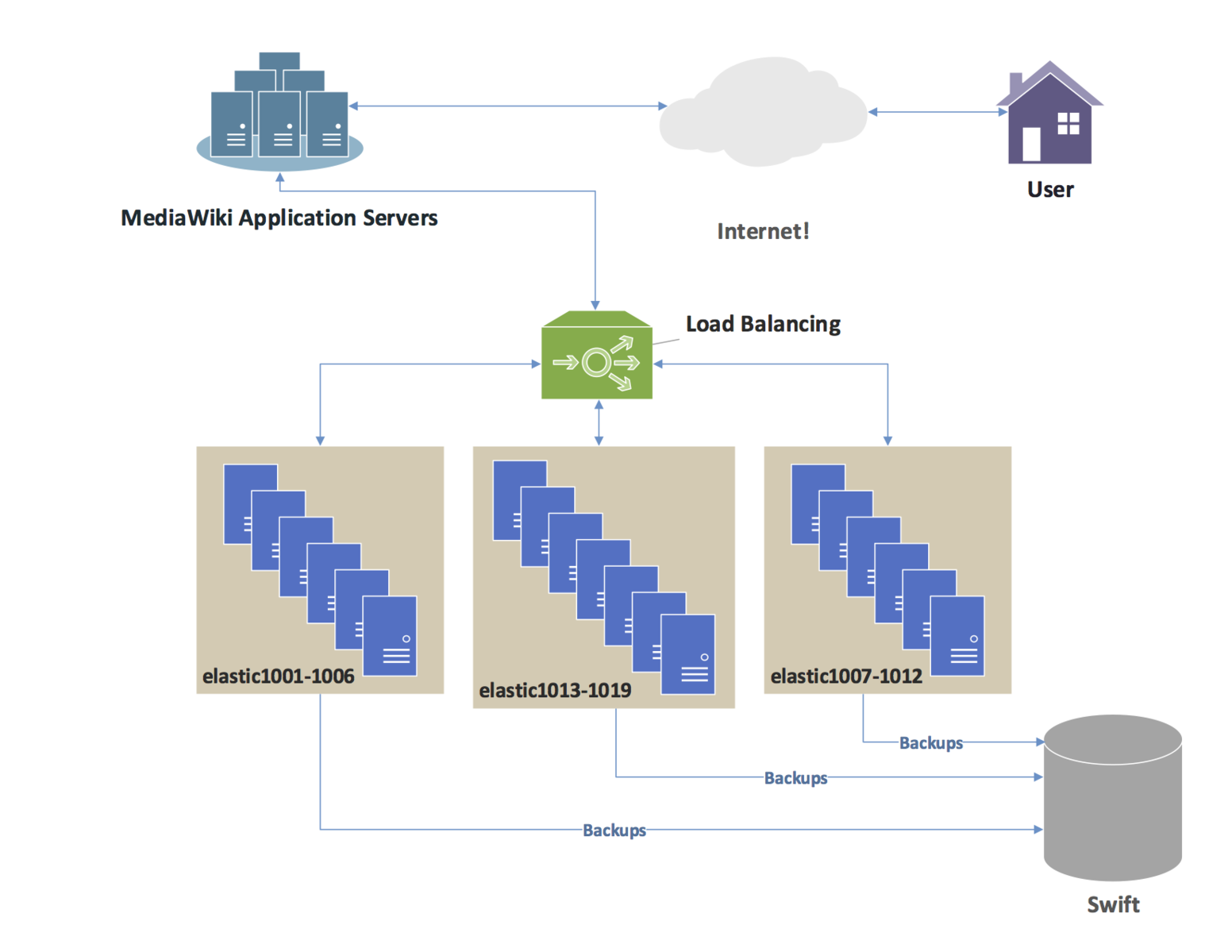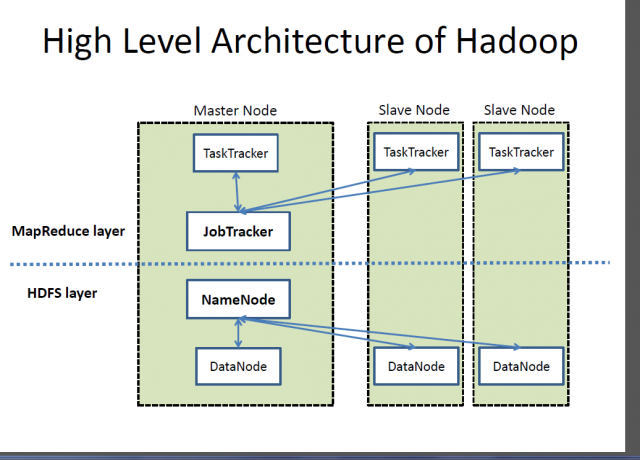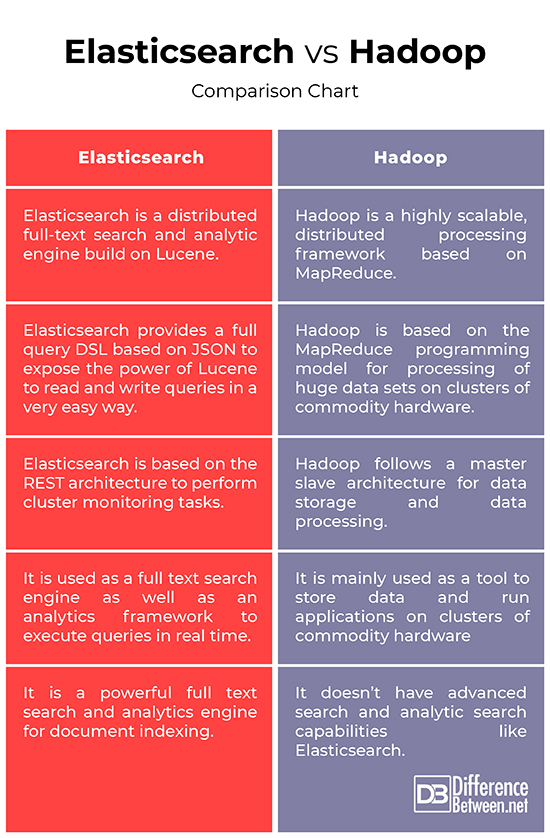Difference Between Elasticsearch and Hadoop
Elasticsearch is a scalable, document-oriented search engine built around Lucene to make all the types of search (including full-text search) and analytics easier. Apart from being a search engine, Elasticsearch is a distributed, multi-tenant document store. Hadoop is a distributed framework that allows to store and process Big Data in a distributed environment across clusters of computers using simple programming models.

What is Elasticsearch?
Elasticsearch is a highly-scalable, distributed full-text search and analytic engine which allows you to store, search and analyze large volumes of data in near real-time. Although it started as a full-text search engine, it is starting to evolve as an analytical engine, which can support complex aggregations. It is build on top of Lucene, a search engine software library written entirely in Java and supported by the Apache Software Foundation. Apache Lucene is one of the most used libraries for searching. Elasticsearch is distributed in nature and is very easy to use which makes it easy to get started and scale as you have more data. Although it is primarily used as a search engine, it can be used as an analytics framework via its powerful aggregation system, and data storage.

What is Hadoop?
Hadoop is a highly scalable, distributed processing framework for managing data processing and storage of large data sets running in clustered systems. Hadoop is a collection of software utilities that allows storing and processing of Big Data and running applications of commodity hardware clusters. Hadoop is the registered trademark of the Apache Software Foundation which began as a single software project to support a web search engine but evolved into an ecosystem of tools and applications used to analyze large volume of data. Hadoop is based on the MapReduce programming model for processing of huge data sets on clusters of commodity hardware. The core component of Hadoop is Hadoop Distributed File System (HDFS) which is a high-performance parallel file system designed to meet the needs of Big Data processing, such as large-block streaming access.
Difference between Elasticsearch and Hadoop
Tool
– Elasticsearch is a highly-scalable, distributed full-text search and analytic engine which allows you to store, search and analyze large volumes of data in near real-time. Although it is primarily used as a search engine, it can be used as an analytics framework via its powerful aggregation system, and data storage. Hadoop, on the other hand, is a powerful distributed processing framework which began as a single software project to support a web search engine but evolved into an ecosystem of tools and applications used to analyze large volume of data.
Architecture
– Hadoop is an open-source software framework that follows a master slave architecture for data storage and data processing using the Hadoop Distributed File System (HDFS) and MapReduce programming model respectively. HDFS is a high-performance parallel file system designed to meet the needs of Big Data processing. Elasticsearch, on the other hand, is based on REST architecture and provides API endpoints to perform CRUD operations over HTTP as well as to perform cluster monitoring tasks. This allows you to integrate, manage and query indexed data in several different ways.
Principle
– Elasticsearch provides a full query DSL based on JSON to expose the power of Lucene to read and write queries in a very easy way. Most NoSQL data stores use JSON to store their data as JSON format is very concise, flexible and easy to understand. Hadoop, on the other hand, is based on the MapReduce programming model for processing of huge data sets on clusters of commodity hardware. MapReduce is a programming paradigm within the Hadoop framework that is used to access vast amounts of data stored across thousands of servers in a Hadoop cluster.
Use
– Elasticsearch is a full text search engine which is its main usage, but it is also used as an analytics framework via its powerful aggregation system. It can also be used as a very powerful analytical engine to execute all the queries that you would usually run in a batch or offline in real-time. It supports not only search but also complex aggregations. Hadoop, on the other hand, is mainly used as a tool to store data and run applications on clusters of commodity hardware using the world’s most reliable storage system, HDFS.
Elasticsearch vs. Hadoop: Comparison Chart

Summary of Elasticsearch vs. Hadoop:
Elasticsearch is a powerful tool for full text search and document indexing build on top of Lucene, a search engine software library written entirely in Java, whereas Hadoop is a data processing framework for handling large volumes of data in a fraction of seconds. Hadoop is based on the popular MapReduce programming model for processing of huge data sets on clusters of commodity hardware. Elasticsearch is a powerful analytics engine to manage your entire analytics pipeline, whereas Hadoop is a framework for handling any data aggregation or transformation job.
- Difference Between Caucus and Primary - June 18, 2024
- Difference Between PPO and POS - May 30, 2024
- Difference Between RFID and NFC - May 28, 2024
Search DifferenceBetween.net :
Leave a Response
References :
[0]Dixit, Bharvi, et al. Elasticsearch: A Complete Guide. Birmingham, United Kingdom: Elasticsearch, 2017. Print
[1]Andhavarapu, Abhishek. Learning Elasticsearch. Birmingham, United Kingdom: Elasticsearch, 2017. Print
[2]Paro, Alberto. Elasticsearch 5.x Cookbook. Birmingham, United Kingdom: Elasticsearch, 2017. Print
[3]Singh, Chanchal and Manish Kumar. Mastering Hadoop 3. Birmingham, United Kingdom: Elasticsearch, 2019. Print
[4]Image credit: https://commons.wikimedia.org/wiki/File:Elasticsearch_Cluster_August_2014.png
[5]Image credit: https://commons.wikimedia.org/wiki/File:Hadoop-HighLevel_hadoop_architecture-640x460.png
